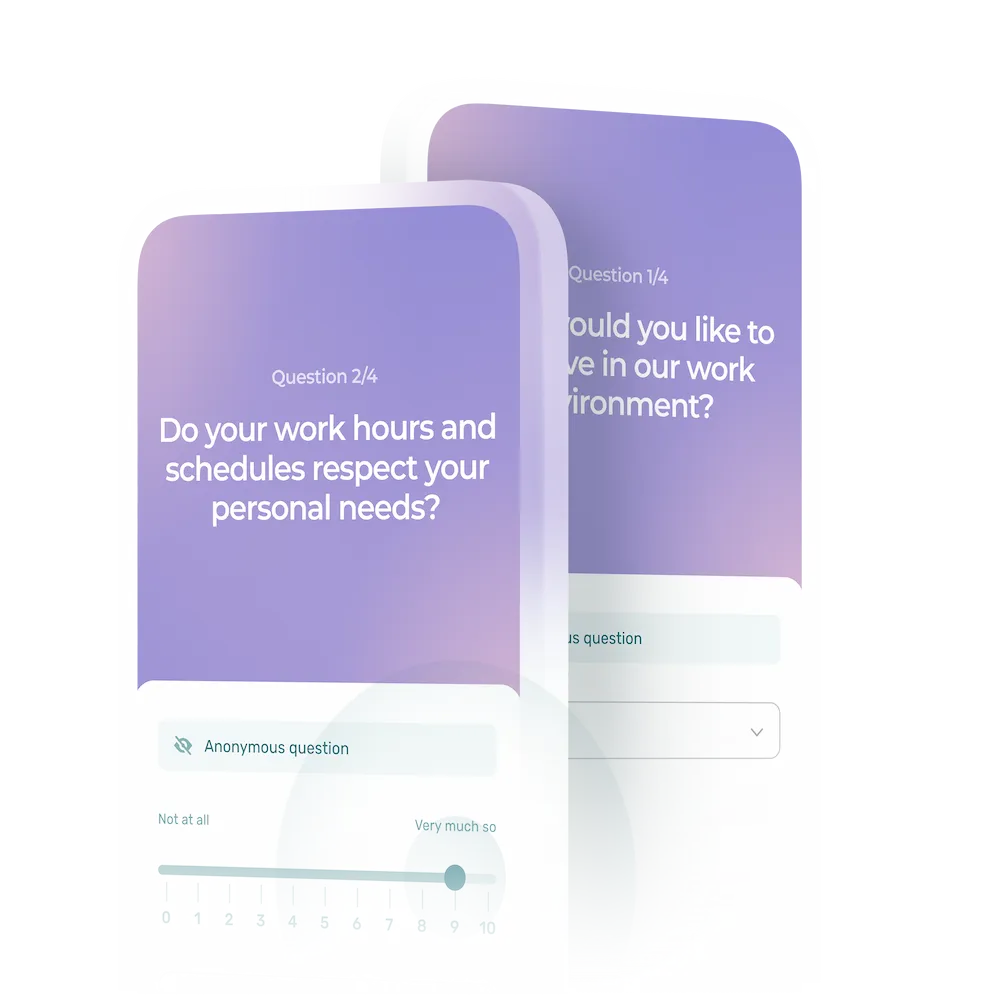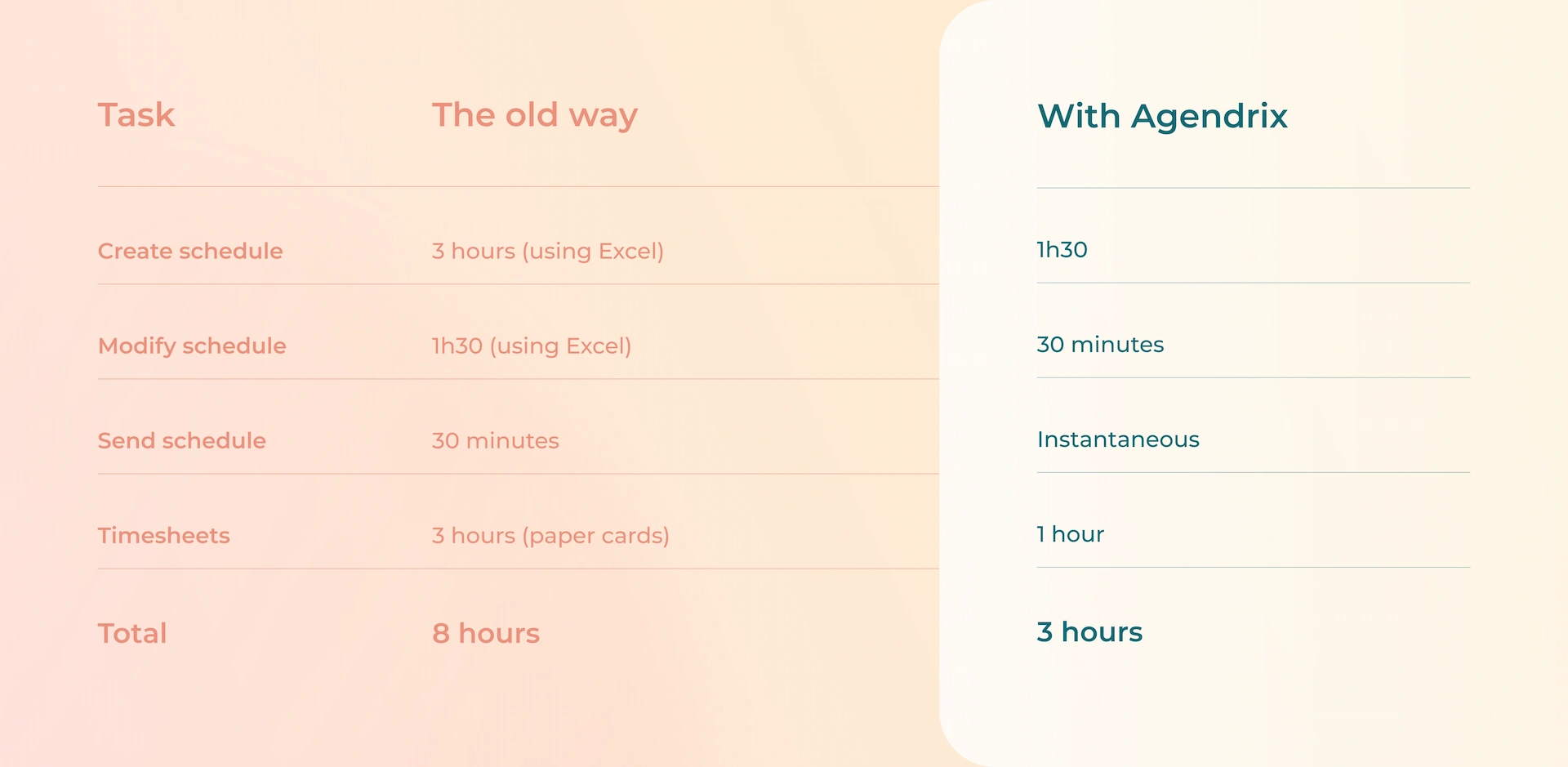7 Tips for Employee-Centric Approach to On-Call Scheduling + Benefits & Template
An on-call schedule can be a great way for businesses to respond quickly to unpredictable customer traffic and issues without necessarily having to increase labor costs.
See the different types of on-call rotations, the pros and cons of having employees work on-call, and best practices for creating an effective on-call schedule.
What Is an On-Call Schedule?
An on-call schedule is a type of shift scheduling where employees can be called in to work without notice. An on-call shift can last a few hours to a full day, and may occur during or outside of the employee’s regular working hours. Employees scheduled to work on on-call rotation may or may not end up working that shift or day, but must remain easily reachable and available to come in to work quickly if needed.
On-call schedules allow businesses to ensure uninterrupted services, minimize downtime, and ensure prompt response during off-hours, and are widely used in healthcare, IT support, customer service, and emergency services. In some circumstances, on-call employees are entitled to on-call pay.
Examples
Here are some examples of jobs that may entail working an on-call schedule.
1. Medical Professionals
Doctors, nurses, paramedics, and other healthcare workers often work on-call to provide emergency medical care or handle critical situations—such as a time-sensitive surgery outside of regular working hours.
2. IT Professionals
IT technicians, system administrators, and helpdesk staff may be on-call to resolve technical issues, major bugs, system failures, or network problems that occur outside of regular business hours.
3. Customer Service Staff
Customer support representatives or call centers agents may be scheduled for on-call shifts to handle urgent or escalated customer inquiries, complaints, or service disruptions that occur during non-standard hours.
4. Maintenance Workers
Maintenance technicians like electricians, plumbers, or HVAC technicians may need to work on-call to handle emergency repairs, equipment failures, or infrastructure issues that can occur at any time. On call engineers are also common.
5. Emergency Responders
Firefighters, police officers, paramedics, and other emergency services personnel often work on-call to provide immediate assistance during emergencies, accidents, or natural disasters.
6. Security Staff
Security guards or officers working for security services may be on-call to ensure the safety and security of a location or respond to security incidents that may occur at any time.
7. Utility Workers
Power line workers, water system operators, and other utility technicians are often on-call should outages, infrastructure damage, or utility emergencies occur and require immediate intervention. On-call engineers are also common.
8. Gig Workers
Examples of gig workers include Uber drivers, fast food delivery drivers and parcel delivery drivers, who often work on an as-needed basis.
Industries That Use On-Call Scheduling
Industries creating a 24-hour shift schedule will often use on-call schedules to quickly respond to unpredictable demand, unexpected issues, and peak hours. Below are just a few examples.
1. Retail
The retail sector may use on-call scheduling to ensure adequate staffing coverage during busy periods, unexpected events, or for seasonal sales and promotions
2. Healthcare
Hospitals, clinics, and emergency medical services often rely on on-call scheduling for doctors, nurses, and others in the medical profession to provide round-the-clock care and respond to emergencies.
3. IT Support
IT departments and software services use on-call scheduling for IT technicians and support staff to handle technical issues and system failures outside of regular business hours.
4. Customer Service
Industries such as telecommunications, e-commerce, and hospitality use on-call scheduling for customer support representatives to serve customers outside of standard working hours.
5. Emergency Services
Cities & municipalities will often use on-call scheduling for their fire departments, police departments, and emergency response teams to ensure immediate availability and response to emergency situations, accidents, or disasters.
6. Maintenance and Facilities Management
Property management companies, manufacturing facilities, and utility providers often have on-call engineers, technicians, or facility managers to address equipment failures, maintenance emergencies, or infrastructure issues.
7. Transportation and Logistics
Airlines, shipping companies, and logistics providers often use on-call scheduling for pilots, truck drivers, or dispatchers to ensure continuous operations and timely responses to unexpected events or disruptions.
8. Hospitality and Tourism
Hotels, resorts, and seasonal & tourism venues often employ on-call scheduling for roles such as concierge, security staff, and maintenance personnel to handle guest requests, security concerns, or facility issues outside of regular working hours.
9. Gig Economy
The gig economy also uses workers such as Uber drivers, fast food delivery drivers and parcel delivery drivers on an ‘as-needed’ or on-call rotation. Working hours and times can vary.
5 Most Common Issues With On-Call Scheduling
Below are some of the common scheduling problems associated with an on-call schedule.
1. Higher Risk of Employee Burnout
On-call scheduling can lead to work-family conflict for employees, particularly when they are scheduled to be on-call for the Sunday shift. It can also lead to stress and burnout among employees who are regularly required to be available outside of their normal working hours.
The unpredictability of on-call shifts and the lack of notice can disrupt work life balance and impact employee well-being. This can result in low job satisfaction and high employee turnover.
Businesses should limit the number of on-call shifts they assign individual employees in one week.
2. Ensuring Schedules Are Fair and Equitable
Ensuring fairness and equity in on-call scheduling can be challenging. Some employees may feel burdened with more frequent on-call shifts, leading to feelings of inequity. It’s important to establish clear and transparent rotation or assignment systems to distribute on-call responsibilities fairly among team members.
Businesses can use employee scheduling software to ensure schedules are fair and equitable.
3. Ensuring Employees Are Available and Responsive
One of the main challenges of on-call scheduling is ensuring that on-call personnel are reachable, responsive, and able to promptly address emergencies or critical situations. Communication issues, technical glitches, or delays in response can negatively impact the effectiveness of on-call support.
Businesses should establish formal communication channels and protocols.
4. Risk of Fatigue and Poor Performance
Being on-call can disrupt sleep patterns and restful downtime, which can result in employee fatigue and poor performance. The pressure to be available at all times, coupled with interrupted sleep or personal time, can affect the quality of work and decision-making during on-call shifts, increasing the risk of workplace accidents.
According to recent research, drivers in the gig economy say they often work long hours during the night shift and have experienced increased fatigue, high physical and mental demand.
- 16% say they are so tired when working the night shift that they struggle to stay awake
- 42% have been in a vehicular accident while at work
- 10% have been in an accident where someone has been hurt
Organizations should create a supportive environment to minimize the negative impact of on-call scheduling on employees. In some situations, businesses can let employees decide their own schedules or consider using alternative scheduling approaches.
5. Complying With Labor Laws
On-call scheduling practices must comply with labor laws and regulations to avoid potential legal issues. Some U.S. states have specific requirements regarding notice periods, compensation, and rest periods for on-call workers. Businesses must stay up to date on applicable labor laws and ensure their scheduling practices adhere to these regulations.
Businesses can use self-audit tools provided by the U.S. Department of Labor to proactively check whether they comply with the Fair Labor Standards Act and other workplace regulations.
What Are the Benefits of an On-Call Schedule?
1. Better Responsiveness
On-call scheduling ensures that there is always someone available to address emergencies, urgent situations, or critical issues that may arise outside of regular working hours.
2. Better Customer Service
On-call scheduling lets organizations provide round-the-clock customer support, ensuring that customer inquiries, complaints, or service disruptions are addressed promptly. This leads to increased customer satisfaction, loyalty, and a positive brand reputation.
3. Lower Labor Costs
On-call scheduling lets organizations optimize staffing levels and allocate resources efficiently. Instead of scheduling a full team to work during non-standard hours, on-call staff can provide coverage to maintain essential services when needed.
4. More Flexibility for Businesses
On-call scheduling makes it easier for organizations to quickly adjust staffing levels to respond to unpredictable events, fluctuations in demand, or unforeseen circumstances. Having the right expertise available when needed means smooth operations and effective problem-solving.
5. More Flexibility for Employees
On-call scheduling gives employees opportunities to earn additional income through on-call pay or allowances. It can also offer flexible work arrangements, giving employees a better work life balance. Some employees may prefer the flexibility and variety that on-call work offers.
Keep employees on the same page with scheduling changes
Share business documents, messages, and work schedules via a professional business communication tool. Send and receive individual or company-wide communications.
5 Types of On-Call Schedules
1. Follow the Sun
A follow-the-sun schedule works well for international organizations with employees working in different time zones. Under a follow-the-sun schedule, employees are on-call during daylight hours in their time zone. This arrangement ensures continuous coverage for the organization.
2. Bi-weekly (Every Other Week)
A bi-weekly schedule makes a good fit for industries such as retail, pharmacies, restaurants, and building maintenance. Employees working a bi-weekly on-call schedule as assigned on-call responsibilities every other week.
This approach ensures fairness and predictability for both the business and employees, which always know when they are on-call rotation
3. Weekday / Weekend
With a weekday / weekend on-call schedule, 1 team works on-call rotation on weekdays and the other team works on-call rotation on weekends.
4. Rotating
On-call rotation schedules are often used in companies with emergency services and/or with high support needs. Employees rotate on-call responsibilities on an hourly, daily, weekly, or monthly basis.
5. Primary & Secondary Contacts
Organizations that want an extra layer of backup will sometimes use an on-call schedule with primary and secondary contacts. If an emergency occurs, the primary contact is the first employee who will be called into work. If this employee cannot be reached, or if an emergency situation requires more hands on deck, a backup person (secondary contact) will also be called in.
What to Consider When Creating On-Call Schedules
When creating on-call schedules, managers should keep the following factors in mind:
1. Workload Distribution
Managers should assess the workload and demands of on-call responsibilities to ensure a reasonable distribution among employees. Avoid overburdening individuals or different teams with excessive on-call work hours, as it can lead to burnout and decreased performance.
2. Employee Preferences and Availability
Consider the personal obligations, commitments, and work-life balance needs of employees when assigning on-call shifts. Conducting employee surveys to understand employee preferences can make a huge difference. It may be that some employees prefer shorter shifts. When possible, allow shift swaps, and grant time-off requests. Employee scheduling software will help you handle overlapping requests.
3. Employee Skills and Expertise
Ensure on-call employees have the necessary skills to handle emergencies or critical situations effectively. Distribute on-call responsibilities among employees with diverse skills to ensure the right person is on the job. Ensure your organization has employee onboarding and training practices.
4. Legal and Compliance Requirements
Consult applicable labor laws, regulations, and collective bargaining agreements governing on-call scheduling. Ensure compliance with relevant laws regarding and employee rights to avoid legal issues or disputes.
5. Communication and Coordination
Establish clear lines of communication and protocols for on-call personnel to ensure seamless coordination and prompt response. Define escalation procedures, provide clear contact information, and establish backup plans in case the primary on-call employee is unavailable or unable to respond. Also have responsibilities outlined clearly for on-call staff.
Best Practices for Creating Employee-Centric On-Call Schedules
Below are some effective scheduling tips for creating an employee-centric on-call schedule.
1. Maintain Open Communication
Maintain open and transparent communication with employees regarding on-call scheduling policies, expectations, and processes. Provide clear guidelines on how scheduling decisions are made and how on-call shifts are assigned.
2. Ensure Fair Rotation
Establish a fair rotation system for on-call shifts to distribute responsibilities equitably among employees. Avoid overburdening certain individuals or teams with excessive on-call duties.
Consider factors like employee preferences, skill sets, and workload distribution when creating the rotation schedule. Using an on-call schedule template or scheduling bettersoftware will make it easier to ensure fair on-call rotation.
3. Give Adequate Notice and Rest Periods
Provide employees with sufficient notice for upcoming on-call shifts. Avoid last-minute changes to the existing schedule whenever possible so that employees can plan their personal lives accordingly. Make sure other employees affected by the change are notified as well. Give employees adequate rest periods between on-call shifts to promote work life balance and prevent burnout.
4. Offer Compensation and Incentives
Offer fair compensation and incentives for on-call work to recognize and reward employees for their availability and responsiveness. Consider providing additional pay, on-call allowances, or other benefits to compensate employees for their commitment to being on-call.
5. Consider Alternative Arrangements
Explore flexible scheduling options or alternatives to traditional on-call shifts, such as voluntary on-call rotations or split shifts to better accommodate employee preferences. Consider implementing technological solutions for remote access so that employees can handle on-call responsibilities more flexibly.
6. Get Employee Input and Feedback
Involve employees in the process of creating on-call schedules by seeking their input and feedback on on-call hours and days. Consider their preferences, constraints, and suggestions to adapt their on-call duty to their needs as much as possible.
7. Monitor and Evaluate Impacts
Regularly monitor and evaluate the impact of on-call scheduling on employee well-being, satisfaction, and performance. Collect feedback from employees and adjust scheduling practices accordingly. Address any concerns or issues promptly to improve the employee experience.
Get started with on-call scheduling today: Download free Excel on-call scheduling template.
Conclusion
Here are some key takeaways on on-call scheduling:
- Employee-centric on-call scheduling practices aim to strike a balance between operational needs and employee well-being.
- Transparent communication, fair rotation, adequate rest periods, and compensation contribute to a positive company culture and work environment.
- Flexibility and continuous monitoring enhance employee satisfaction and engagement.
- These practices result in improved customer experience and operational efficiency.
- By prioritizing employees, organizations create a supportive environment where employees thrive while meeting service demands.
Get On-Call Scheduling Right the First Time
Businesses of all sizes and industries use Agendrix’s workforce management software to easily create an effective on-call schedule.
- Communicate schedules
- Give employees various ways to clock
- Track time & attendance at multiple job sites
- Have timesheets automatically filled out
- Keep employee records up to date
- Give proper recognition to employees who go the extra mile
- Manage the entire employee onboarding experience
- Conduct employee surveys
How Much Time Can an Organization Save by Using Agendrix for On-Call Scheduling?











